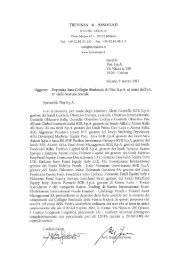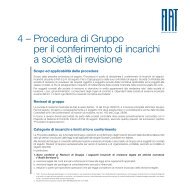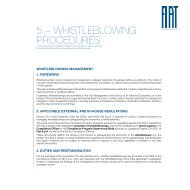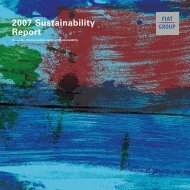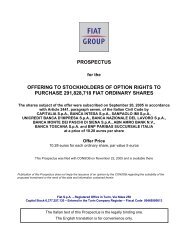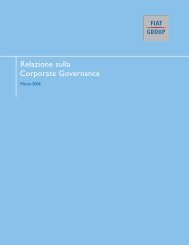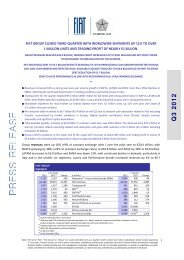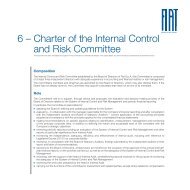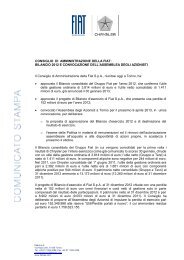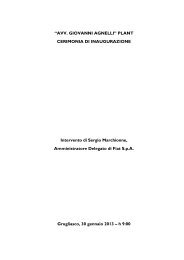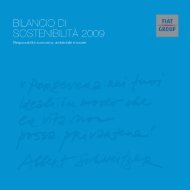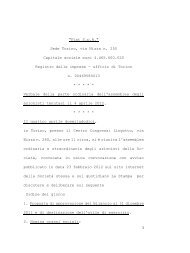2006 Annual Report - Fiat SpA
2006 Annual Report - Fiat SpA
2006 Annual Report - Fiat SpA
You also want an ePaper? Increase the reach of your titles
YUMPU automatically turns print PDFs into web optimized ePapers that Google loves.
Measurement<br />
Investments in unconsolidated companies classified as<br />
non-current financial assets are accounted for as described<br />
in the section Basis of consolidation.<br />
Non-current financial assets other than investments, as well<br />
as current financial assets and financial liabilities, are<br />
accounted for in accordance with IAS 39 – Financial<br />
Instruments: Recognition and Measurement.<br />
Current financial assets and held-to-maturity securities are<br />
recognised on the basis of the settlement date and, on initial<br />
recognition, are measured at acquisition cost, including<br />
transaction costs.<br />
Subsequent to initial recognition, available-for-sale and held<br />
for trading financial assets are measured at fair value. When<br />
market prices are not available, the fair value of available-forsale<br />
financial assets is measured using appropriate valuation<br />
techniques e.g. discounted cash flow analysis based on market<br />
information available at the balance sheet date.<br />
Gains and losses on available-for-sale financial assets are<br />
recognised directly in equity until the financial asset is<br />
disposed or is determined to be impaired, at which time<br />
the cumulative gains or losses, including that previously<br />
recognised in equity, are included in the income statement<br />
for the period. Gains and losses arising from changes in fair<br />
value of held for trading financial instruments are included<br />
in the income statement for the period.<br />
Loans and receivables which are not held by the Group for<br />
trading (originated loans and receivables), held-to-maturity<br />
securities and all financial assets for which published price<br />
quotations in an active market are not available and whose<br />
fair value cannot be determined reliably, are measured, to<br />
the extent that they have a fixed term, at amortised cost, using<br />
the effective interest method. When the financial assets do not<br />
have a fixed term, they are measured at acquisition cost.<br />
Receivables with maturities of over one year which bear no<br />
interest or an interest rate significantly lower than market rates<br />
are discounted using market rates.<br />
98 <strong>Fiat</strong> Group Consolidated Financial Statements at December 31, <strong>2006</strong> - Notes<br />
Assessments are made regularly as to whether there is any<br />
objective evidence that a financial asset or group of assets<br />
may be impaired. If any such evidence exists, an impairment<br />
loss is included in the income statement for the period.<br />
Except for derivative instruments, financial liabilities are<br />
measured at amortised cost using the effective interest<br />
method. Financial liabilities hedged by derivative instruments<br />
are measured in accordance with hedge accounting principles<br />
applicable to fair value hedges: gains and losses arising from<br />
remeasurement at fair value, due to changes in relevant<br />
hedged risk, are recognised in the income statement and are<br />
offset by the effective portion of the loss or gain arising from<br />
remeasurement at fair value of the hedging instrument.<br />
Derivative financial instruments<br />
Derivative financial instruments are only used for hedging<br />
purposes, in order to reduce currency, interest rate and market<br />
price risks. In accordance with IAS 39, derivative financial<br />
instruments qualify for hedge accounting only when at the<br />
inception of the hedge there is formal designation and<br />
documentation of the hedging relationship, the hedge is<br />
expected to be highly effective, its effectiveness can be reliably<br />
measured and it is highly effective throughout the financial<br />
reporting periods for which the hedge is designated.<br />
All derivative financial instruments are measured in<br />
accordance with IAS 39 at fair value.<br />
When derivative financial instruments qualify for hedge<br />
accounting, the following accounting treatment applies:<br />
■ Fair value hedge – Where a derivative financial instrument<br />
is designated as a hedge of the exposure to changes in fair<br />
value of a recognised asset or liability that is attributable to<br />
a particular risk and could affect the income statement, the<br />
gain or loss from remeasuring the hedging instrument at fair<br />
value is recognised in the income statement. The gain or loss<br />
on the hedged item attributable to the hedged risk adjusts the<br />
carrying amount of the hedged item and is recognised in the<br />
income statement.<br />
■ Cash flow hedge – Where a derivative financial instrument<br />
is designated as a hedge of the exposure to variability in future<br />
cash flows of a recognised asset or liability or a highly<br />
probable forecasted transaction and could affect income<br />
statement, the effective portion of any gain or loss on the<br />
derivative financial instrument is recognised directly in equity.<br />
The cumulative gain or loss is removed from equity and<br />
recognised in the income statement at the same time as the<br />
economic effect arising from the hedged item affects income.<br />
The gain or loss associated with a hedge or part of a hedge<br />
that has become ineffective is recognised in the income<br />
statement immediately. When a hedging instrument or hedge<br />
relationship is terminated but the hedged transaction is still<br />
expected to occur, the cumulative gain or loss realised to the<br />
point of termination remains in stockholders’ equity and is<br />
recognised in the income statement at the same time as the<br />
related transaction occurs. If the hedged transaction is no<br />
longer probable, the cumulative unrealised gain or loss held<br />
in stockholders’ equity is recognised in the income statement<br />
immediately.<br />
If hedge accounting cannot be applied, the gains or losses<br />
from the fair value measurement of derivative financial<br />
instruments are recognised immediately in the income<br />
statement.<br />
Sales of receivables<br />
The <strong>Fiat</strong> Group sells a significant part of its financial, trade<br />
and tax receivables through either securitisation programs<br />
or factoring transactions.<br />
A securitisation transaction entails the sale of a portfolio of<br />
receivables to a securitisation vehicle. This special purpose<br />
entity finances the purchase of the receivables by issuing<br />
asset-backed securities (i.e. securities whose repayment and<br />
interest flow depend upon the cash flow generated by the<br />
portfolio). Asset-backed securities are divided into classes<br />
according to their degree of seniority and rating: the most<br />
senior classes are placed with investors on the market; the<br />
junior class, whose repayment is subordinated to the senior<br />
classes, is normally subscribed for by the seller. The residual<br />
interest in the receivables retained by the seller is therefore<br />
limited to the junior securities it has subscribed for. In<br />
accordance with SIC-12 – Consolidation – Special Purpose<br />
Entities (SPE), all securitisation vehicles are included in the<br />
scope of consolidation, because the subscription of the junior<br />
asset-backed securities by the seller entails its control in<br />
substance over the SPE.<br />
Furthermore, factoring transactions may be with or without<br />
recourse to the seller; certain factoring agreements without<br />
recourse include deferred purchase price clauses (i.e. the<br />
payment of a minority portion of the purchase price is<br />
conditional upon the full collection of the receivables), require<br />
a first loss guarantee of the seller up to a limited amount or<br />
imply a continuing significant exposure to the receivables<br />
cash flow. These kinds of transactions do not meet IAS 39<br />
requirements for assets derecognition, since the risks<br />
and rewards have not been substantially transferred.<br />
Consequently, all receivables sold through both securitisation<br />
and factoring transactions which do not meet IAS 39<br />
derecognition requirements are recognised as such in the<br />
Group financial statements even though they have been legally<br />
sold; a corresponding financial liability is recorded in the<br />
consolidated balance sheet as “Asset-backed financing”.<br />
Gains and losses relating to the sale of such assets are not<br />
recognised until the assets are removed from the Group<br />
balance sheet.<br />
Inventory<br />
Inventories of raw materials, semi finished products<br />
and finished goods are stated at the lower of cost and net<br />
realisable value, cost being determined on a first in-first-out<br />
(FIFO) basis. The measurement of inventories includes the<br />
direct costs of materials, labour and indirect costs (variable<br />
and fixed). Provision is made for obsolete and slow-moving<br />
raw materials, finished goods, spare parts and other supplies<br />
based on their expected future use and realisable value. Net<br />
realisable value is the estimated selling price in the ordinary<br />
course of business less the estimated costs of completion<br />
and the estimated costs for sale and distribution.<br />
<strong>Fiat</strong> Group Consolidated Financial Statements at December 31, <strong>2006</strong> - Notes 99



